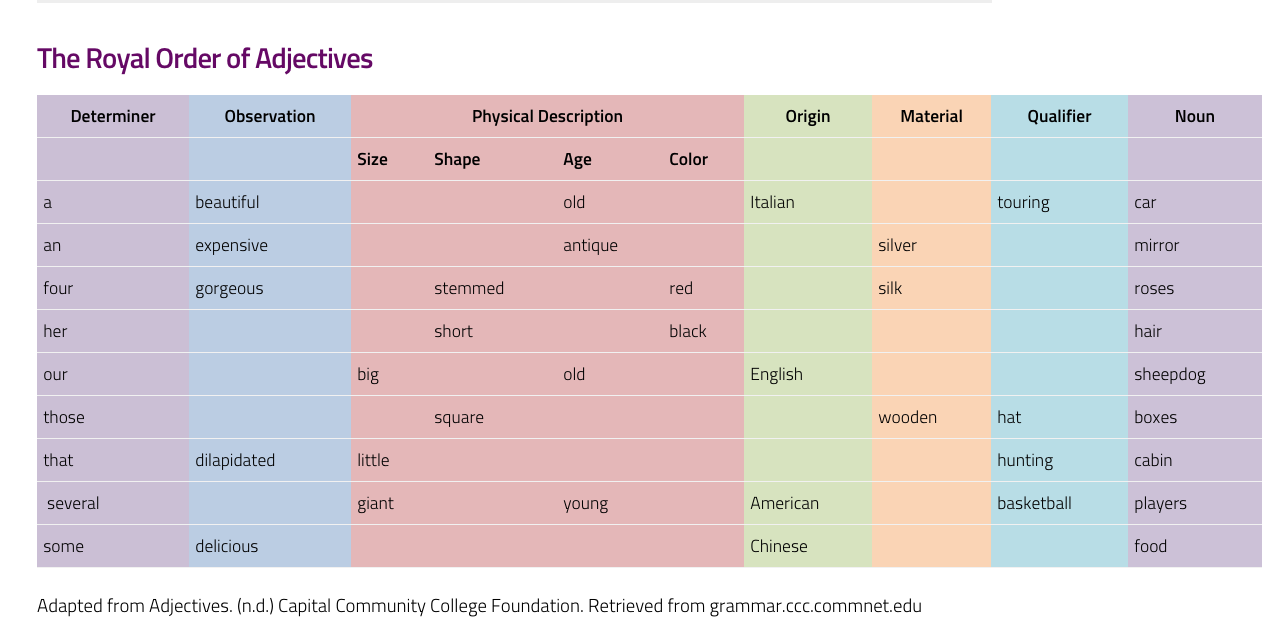Adverbs
Adverbs often end in –ly and modify verbs, other adverbs, and adjectives. As a rule, you should place an adverb next to or close to the word it modifies, although adverbs can be placed in different positions within a sentence without affecting its meaning.
Example
- Before the verb: “He slowly walked to the store.”
- After the verb: “He walked slowly to the store.”
- At the beginning of the sentence: “Slowly, he walked to the store.”
- At the end of the sentence: “He walked to the store slowly.”
- Between an auxiliary and main verb: “He was slowly walking to the store.”
Some adverbs, however, have a different meaning based on where they are placed. You should check to make sure that your placement carries the intended meaning.
Example
- “She only loved him.”
- Translation: “The only emotion she felt toward him was love.”
- “Only she loved him.”
- Translation: “The only person who loved him was her.”
- “She loved only him.” or “She loved him only.”
- Translation: “The only person she loved was him.”
- Some adverbs simply do not work between the verb and the direct object in a sentence.
Example
Acceptable adverb placement: She barely heard the noise.
Unacceptable adverb placement: She heard barely the noise.
Adjectives
Adjectives modify nouns and in some more heavily inflected languages, the endings of adjectives change to agree with the number and gender of the noun. In English, adjectives do not change in this way. For example, within the following sentences, note how the spelling of the adjective “eager” remains the same, regardless of the number or the gender of the noun it modifies.
- The eager boy jumped the starting gun.
- The eager boys lined up.
- The eager girls eyed the starter.
As in these sentences, adjectives usually are placed before a noun. The noun can be the subject, as in the preceding example, or a direct object, as in the following sentence.
- Harold admired his shiny red car.
Adjectives can also be placed after a linking verb. The adjective still modifies a noun but is not placed next to the noun, as in the following example.
- The weather was miserable.
When two or more adjectives are used to modify a single noun, they should be used in a set order, as shown in The Royal Order of Adjectives. Even though the table shows several levels within the hierarchy, you should limit your adjectives per noun to two or three.

|
Determiner |
Opinion or Assessment |
Physical Description |
Nationality |
Religion |
Material |
Noun |
|||
|
Size |
Shape |
Age |
Color |
||||||
|
The |
pretty |
small |
thin |
young |
white |
French |
Methodist |
plastic |
girl |
When using an adverb and adjective together with a noun, you should typically place the adverb first, followed by the adjective, and then the noun.
- the strikingly golden tree
You can also check out this video on Adjective Order from Khan Academy:
For more information about adverbs and adjectives, see Chapter 20 “Grammar”, Section 20.6 “Using Adverbs and Adjectives”.
This chapter is a synthesis of two Creative Commons texts:
“Order of Adjectives” from Excelsior Online Writing Lab, 2019, used according to Creative Commons 4.0 CC BY 4.0
“Using Adverbs and Adjectives” from Writer’s Handbook, 2012, used according to Creative Commons CC CC BY-NC-SA 3.0